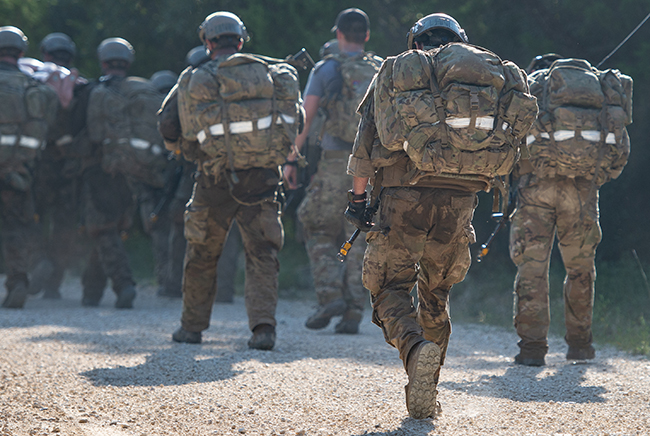
TACP airmen complete a Field Training Exercise at JBSA-Camp Bullis, Texas, on Jul. 11, 2019. Air Force Photo by Andrew C. Patterson.
The training pipeline for special-operations airmen is steadily improving, leading to incrementally better manning levels, the head of Air Force Special Operations Command told reporters Sept. 16.
The pipeline for combat controllers, pararescuemen, and other AFSOC specialties has long faced challenges because those training programs are so difficult, Lt. Gen. James C. Slife said at a media roundtable at AFA’s Air, Space & Cyber Conference. But while the niche careers have room to grow, they aren’t currently hurting for people.
“We’ve seen steady improvements in our ability to generate throughput in those pipelines,” Slife said. “We’re at a pretty sustainable level, and we’re growing the force to fill out the units and our deployment packages that we have within the units. But right now, we’re healthy and on our way to full manning in all those communities.”
AFSOC is working to meet a 1-to-2 deploy-to-dwell ratio mandated by the Secretary of Defense, meaning troops must spend twice as much time at home as they do performing their job.
“We’ve got a holistic look across each one of our specialties to see where our pressure points are for that,” Slife said. “We have a lot of our forces hovering right there, around that level. Depending on the day-to-day manning snapshot, sometimes we have career fields that’ll bounce underneath that. But I’m pretty comfortable with the steps that the Air Force and [US Special Operations Command] have taken with respect to both manning and also the deployments that we’re being tasked with.”
He believes the command can sustain its current deployment rate, but has to keep an eye on the health of certain specialty codes like combat controllers, pararescue, and AC-130 gunners.
At the same time, AFSOC is still working to bring women into its special-warfare units. The command has tasked a recruiting squadron to focus on bringing women into the last combat career fields, opened to them in 2016, such as new combat controllers, pararescuemen, and tactical air control party specialists.
“We have always approached this from a standards perspective,” Slife said. “This is something that we’ve asked our recruiting squadron to pay particular attention to, to make sure that we’re reaching out to the communities of young women that we feel like have the ability to meet the standards that we have for those career fields.”
He pointed to the first female airman to earn an Army Ranger tab as an example of the type of women AFSOC should recruit. Female aviators have reached the top echelons of uniformed Air Force leadership, he said—why not in the special tactics community as well
“It’s a matter of finding the right demographic, and then painting a picture for them that, ‘hey, there is a place for you in this force,’ ” Slife said. “Sometimes, it’s hard when you can’t see somebody that looks like you in the community, it’s hard to see what your future looks like there. And so we’re anxious to find the right demographics of young women that we can specifically go target with our recruiting and bring them in, and then use them as role models.”